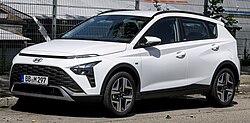Hyundai-Kia K platforms
Motor vehicle platform From Wikipedia, the free encyclopedia
The K platform series are platforms developed by Hyundai and Kia for its range of automobiles since 2017.
| Hyundai-Kia K platforms | |
|---|---|
| Overview | |
| Manufacturer | Hyundai Kia Motors |
| Production | 2017–present |
| Body and chassis | |
| Class | City car (A) Subcompact car/supermini (B) Compact car (C) |
| Layout | Front-engine, front-wheel-drive Front-engine, all-wheel-drive |
| Platform |
|
| Chronology | |
| Predecessor | Hyundai-Kia SA platform Hyundai-Kia BA platform Hyundai-Kia PB platform Hyundai-Kia GB platform Hyundai-Kia J6 platform |
K1 platform
The K1 platform is utilized for entry subcompact models (A-segment). It was introduced in 2018 coinciding with the launch of the second generation Hyundai Santro, replacing the SA platform and BA platform. It is a modified version of the SA platform, and Hyundai claimed the K1 platform is 63 percent more rigid than its predecessor. Two wheelbase variations are available, which are 2,400 mm (94.5 inches) and 2,450 mm (96.5 inches).
Vehicles using platform (calendar years):
- Hyundai Santro/Atos/Eon (AH2) (2018–2022)[1]
- Hyundai Grand i10 Nios (AI3) (2019–present)[2]
- Hyundai Aura/Grand i10 sedan (AI3) (2020–present)[3]
- Hyundai Casper (AX1) (2021–present)[4]
- Hyundai Exter (AI3 CUV) (2023–present)
- Kia Syros (AY) (2025–present)
K1 BEV platform
Introduced in 2024, the K1 BEV platform is a dedicated battery electric vehicle platform for the small-segment of Hyundai E-GMP derived from the K1 platform.
- Hyundai Casper Electric / Inster (AX1 EV) (2024–present)
K2 platform
Summarize
Perspective
Introduced in 2016, the K2 platform is mainly utilized for B-segment and small C-segment vehicles. Wheelbase variations for this platform ranging between 2,500 mm (98.4 inches) and 2,760 mm (108.7 inches). The platform is able to support models with three-row seating.[5] It is derived from the PB platform and GB platform, while also replacing them.
Vehicles using platform (calendar years):
- Hyundai i20 (BC3/BI3) (2020–present)[6]
- Hyundai Accent/Verna/Solaris (HC/YC) (2017–2023)[7][8][9]
- Hyundai Tucson (TL) (2015–2021)
- Hyundai i30 (PD) (2016–present)[10][11]
- Hyundai Venue (QX) (2019–present)[12][13]
- Hyundai Bayon (BC3 CUV) (2021–present)
- Hyundai Creta/ix25 (SU2) (2019–present)[14]
- Hyundai Alcazar (SU2 LWB) (2021–present)[15]
- Hyundai Stargazer (KS) (2022–present)
- Kia Sportage (QL) (2015–2021)
- Kia Rio/K2/KX Cross (FB) (2017–2022)[16]
- Kia Ceed/ProCeed/XCeed (CD) (2018–present)[17][18]
- Kia Sonet (QY) (2020–present)[14]
- Kia Seltos/KX3 (SP2i/SP2c) (2019–present)[14][19]
- Kia Carens (KY) (2022–present)[citation needed]
K2 BEV platform
Introduced in 2025, the K2 BEV platform is a dedicated battery electric vehicle platform for the small-segment of Hyundai E-GMP derived from the K2 platform.
- Hyundai Creta Electric (2025–present)
K3 platform
Introduced in 2020, the K3 platform is an all-new platform for C-segment vehicles as the successor to J platform series. Dubbed as the third-generation platform,[20] Hyundai claimed the platform allowed engineers to lower the center of gravity for more agile handling. The platform also improves safety due to the usage of a multiload path structure.
- Hyundai Elantra/Avante/i30 sedan (CN7) (2020–present)[21][22]
- Hyundai Accent/Verna (BN7) (2020–present)
- Hyundai Kona (SX2) (2022–present)
- Kia Niro (SG2) (2021–present)[23]
- Kia K3 (BL7) (2023–present)
- Kia K4 (CL4) (2024–present)
K3 BEV platform
Introduced in 2024, the K3 BEV platform is a dedicated battery electric vehicle platform for the small-segment of Hyundai E-GMP derived from the K3 platform.
- Kia EV3 (SV) (2024–present)
References
Wikiwand - on
Seamless Wikipedia browsing. On steroids.






























